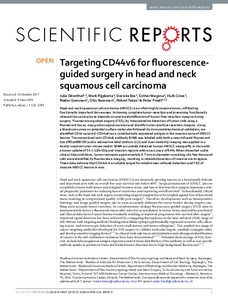Targeting CD44v6 for fluorescence-guided surgery in head and neck squamous cell carcinoma
Julia Odenthal; Mark Rijpkema; Desirée Bos; Esther Wagena; Huib Croes; Reidar Grenman; Otto Boerman; Robert Takes; Peter Friedl
https://urn.fi/URN:NBN:fi-fe2021042719292
Tiivistelmä
Head and neck squamous cell carcinoma (HNSCC) is an often highly invasive tumor, infiltrating functionally important tissue areas. Achieving complete tumor resection and preserving functionally relevant tissue structures depends on precise identification of tumor-free resection margins during surgery. Fluorescence-guided surgery (FGS), by intraoperative detection of tumor cells using a fluorescent tracer, may guide surgical excision and identify tumor-positive resection margins. Using a literature survey on potential surface molecules followed by immunohistochemical validation, we identified CD44 variant 6 (CD44v6) as a constitutively expressed antigen in the invasion zone of HNSCC lesions. The monoclonal anti-CD44v6 antibody BIWA was labeled with both a near-infrared fluorescent dye (IRDye800CW) and a radioactive label (Indium-111) and dual-modality imaging was applied in a locally invasive tumor mouse model. BIWA accurately detected human HNSCC xenografts in mice with a tumor uptake of 54 ± 11% ID/g and invasion regions with an accuracy of 94%. When dissected under clinical-like conditions, tumor remnants approximately 0.7 mm in diameter consisting of a few thousand cells were identified by fluorescence imaging, resulting in reliable dissection of invasive microregions. These data indicate that CD44v6 is a suitable target for reliable near-infrared detection and FGS of invasive HNSCC lesions in vivo.
Kokoelmat
- Rinnakkaistallenteet [27094]
